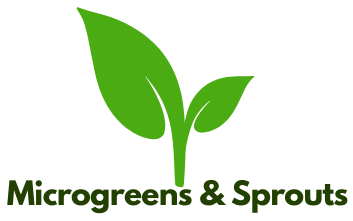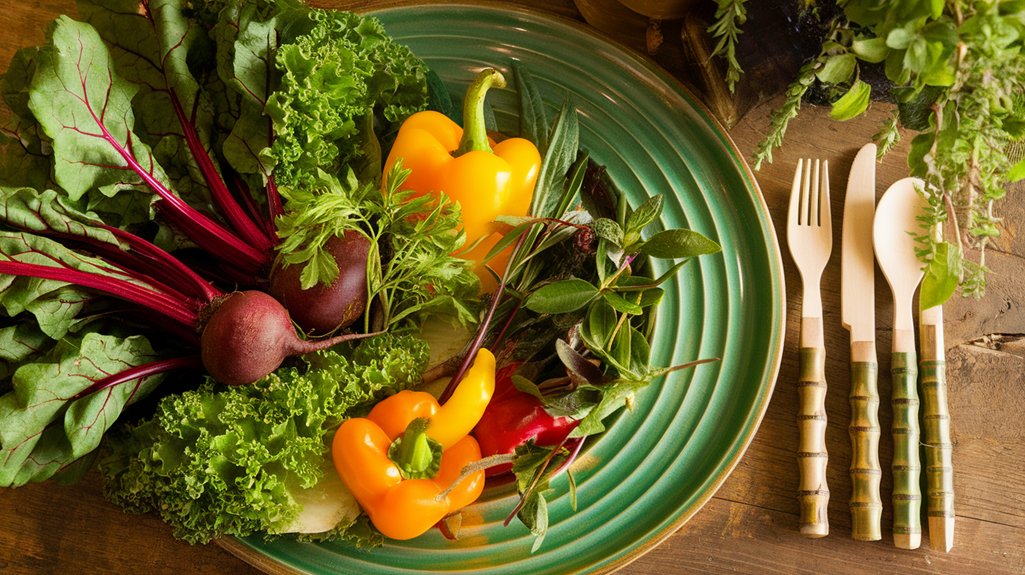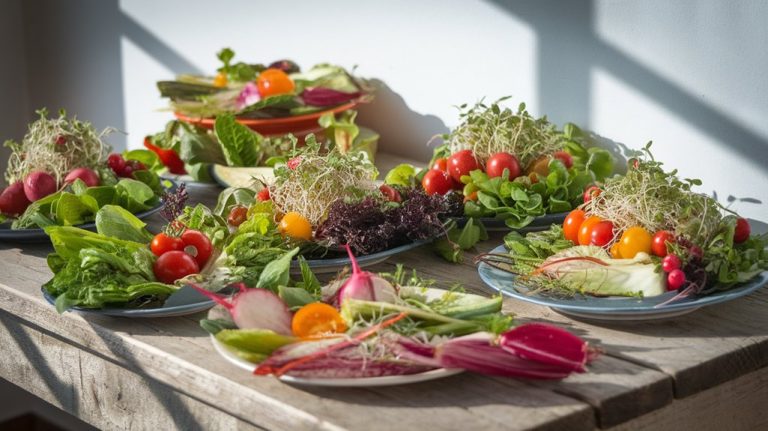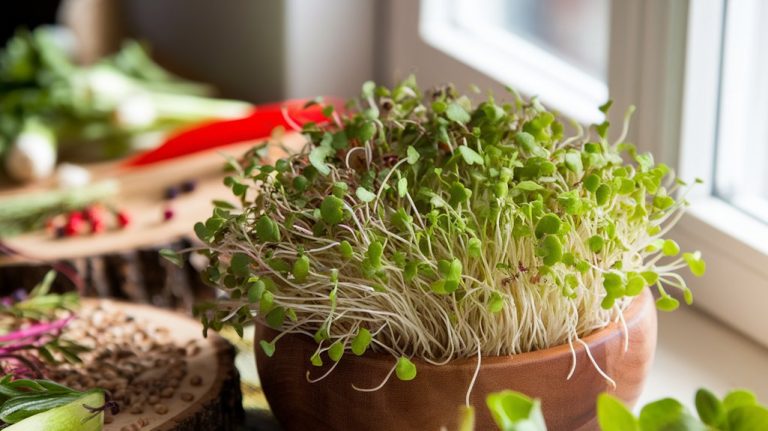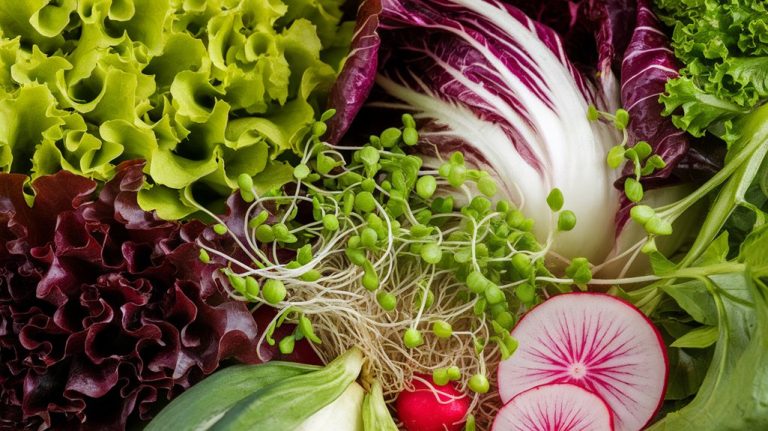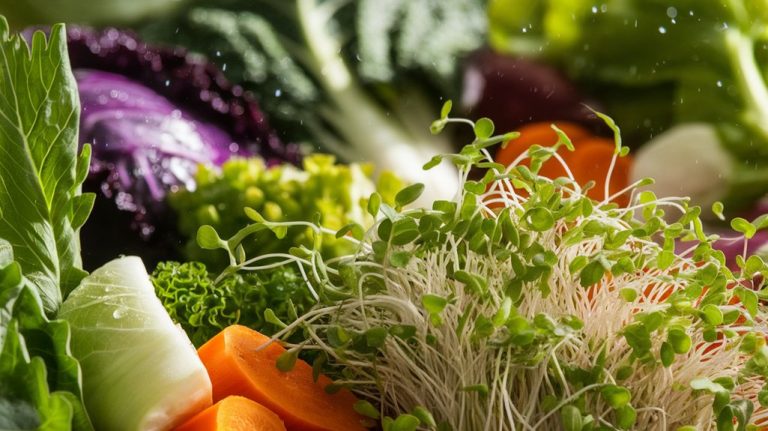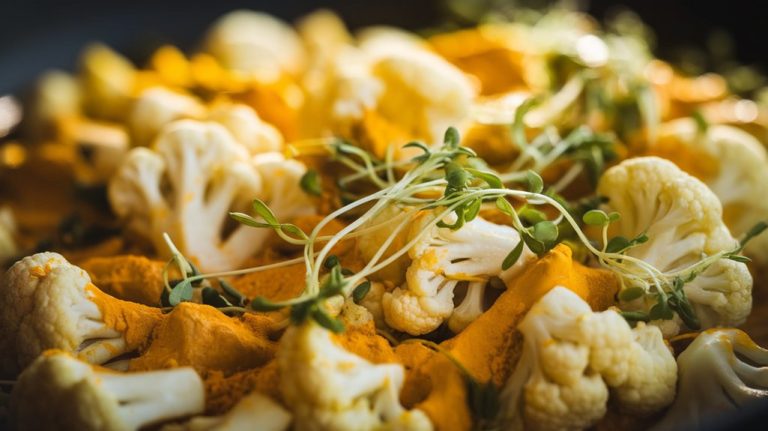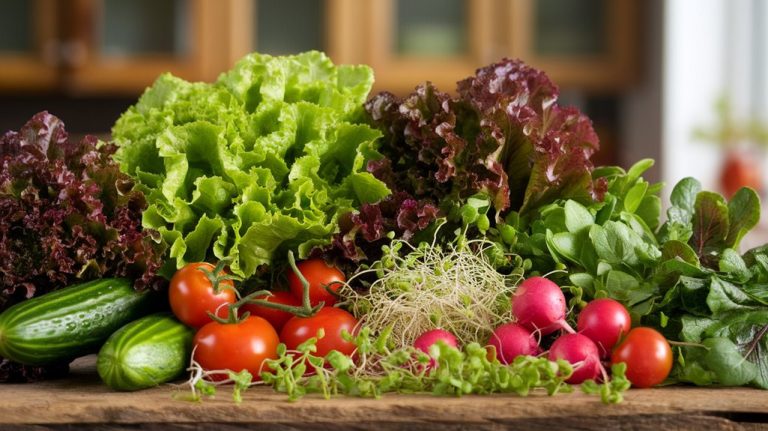The Green Plate Revolution for Vegetarians
The Green Plate Revolution‘s all about transforming our dining habits by celebrating the joy of plant-based meals. I’ve found that embracing colorful ingredients, fresh produce, and local connections not only nourishes my body but also benefits the planet. This movement encourages community engagement through potlucks and cooking classes, fostering a supportive environment. Plus, the health benefits and environmental impact of vegetarianism are astounding. Stick around, and I’ll share more about how to embark on this culinary adventure!
Key Takeaways
- The Green Plate Revolution promotes plant-based dining that emphasizes flavor, creativity, and health through colorful, fresh ingredients.
- Community engagement is essential, fostering connections through potlucks, cooking classes, and local advocacy for vegetarian initiatives.
- Adopting a vegetarian lifestyle significantly reduces environmental footprints, lowering greenhouse gas emissions and resource consumption compared to meat production.
- Innovative meat alternatives and sustainable eating practices enhance culinary experiences while promoting environmental friendliness and biodiversity.
- Starting a vegetarian journey involves gradually incorporating plant-based meals and exploring local produce, spices, and new ingredients for flavorful dishes.
Understanding the Green Plate Revolution
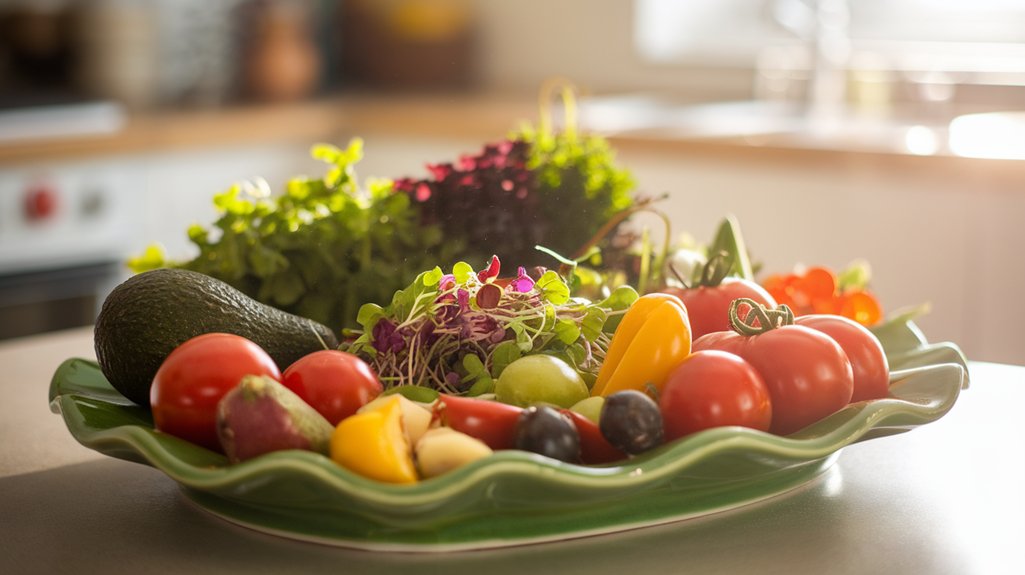
As I dive into the Green Plate Revolution, I can’t help but feel excited about the vibrant transformation of our dining habits.
This movement isn’t just about swapping meat for veggies; it’s a celebration of flavor, creativity, and health. I’ve discovered that embracing plant-based meals opens up a world of colorful ingredients, from zesty spices to hearty grains.
Each dish becomes an adventure, filled with textures and aromas that tantalize the senses. I’ve found that cooking with fresh, seasonal produce not only nourishes my body but also sparks joy in my kitchen.
The Green Plate Revolution inspires us to rethink what’s on our plates and encourages connections with local farmers, fostering a community that prioritizes wellness and sustainability.
It’s truly a delicious journey!
The Environmental Impact of Vegetarianism
While many may not realize it, choosing a vegetarian lifestyle can significantly reduce our environmental footprint. By opting for plant-based meals, we’re not just nourishing ourselves, but also protecting our planet. The production of meat contributes to greenhouse gas emissions, deforestation, and water pollution. In contrast, plant-based diets typically require fewer resources, resulting in a lower impact on the environment.
Here’s a quick comparison of the environmental impact of meat versus vegetarian diets:
| Food Type | Greenhouse Gas Emissions (kg CO2e) | Water Usage (liters) |
|---|---|---|
| Beef | 27.0 | 15,415 |
| Chicken | 6.0 | 4,325 |
| Lentils | 0.9 | 1,000 |
| Spinach | 0.4 | 1,200 |
| Tofu | 2.0 | 3,000 |
Making this switch can lead to a healthier planet!
Health Benefits of a Plant-Based Diet
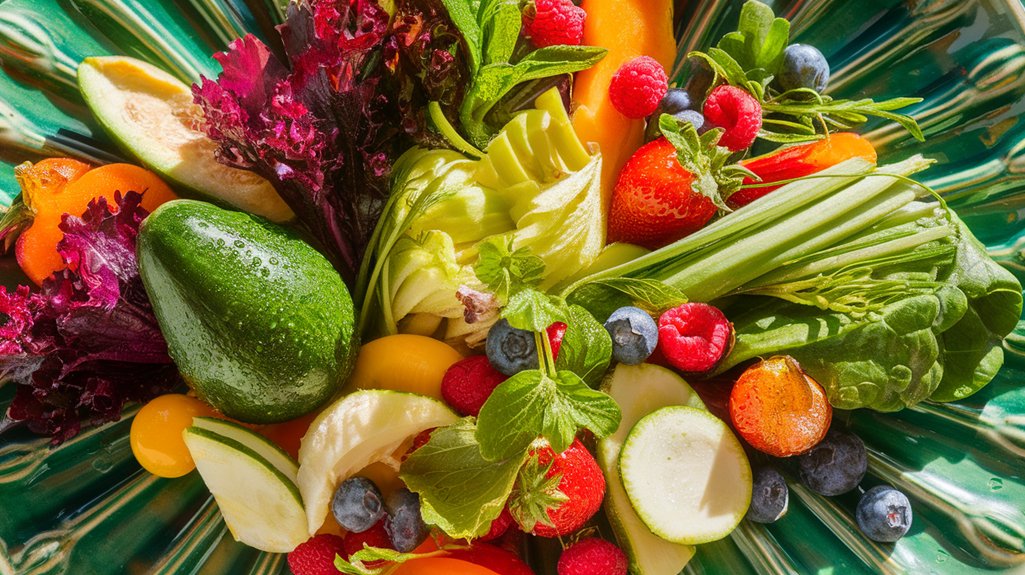
The moment I embraced a plant-based diet, I discovered a world of health benefits that transformed my overall well-being. My energy levels soared, and I felt lighter, both physically and mentally.
Here are some key benefits I experienced:
- Improved Digestion: The fiber-rich foods kept my gut happy and regular, reducing bloating and discomfort.
- Weight Management: I found it easier to maintain a healthy weight, as plant-based foods tend to be lower in calories and high in nutrients.
- Heart Health: My cholesterol levels dropped, and I felt a renewed sense of vitality, knowing I was supporting my heart.
Switching to a plant-based diet not only rejuvenated my body but also ignited my passion for vibrant, wholesome foods.
Exploring Innovative Meat Alternatives
As I explore the world of innovative meat alternatives, I’m amazed by the variety of plant-based proteins that are transforming our plates.
From sustainable ingredients to culinary innovations, these options aren’t just delicious but also environmentally friendly.
Join me as we uncover how these advancements are revolutionizing our dining experience.
Plant-Based Proteins Revolution
With a growing awareness of health and environmental concerns, I’ve found myself immersed in the exciting world of plant-based proteins.
These innovative meat alternatives not only offer a delicious experience but also cater to diverse dietary needs. Here are a few standout options I’ve explored:
- Jackfruit: This versatile fruit mimics pulled pork beautifully, soaking up flavors and spices.
- Lentils: Packed with protein and fiber, they serve as a hearty base for veggie burgers and stews.
- Chickpeas: Whether roasted or blended into hummus, they’re a protein-rich snack or meal component.
Sustainable Ingredients Trend
While exploring the realm of sustainable ingredients, I’ve discovered that innovative meat alternatives are reshaping our culinary landscape.
These alternatives, crafted from peas, lentils, and mushrooms, not only mimic the texture and flavor of traditional meats but also boast impressive nutritional profiles.
I’ve found that brands are pushing boundaries, creating products like jackfruit pulled “pork” and chickpea-based “chicken” that satisfy cravings while being kinder to our planet.
The rise of lab-grown meats adds another layer, promising sustainability without sacrificing taste.
As I delve deeper into this world, I realize that these alternatives aren’t just for vegetarians; they invite everyone to rethink their food choices.
It’s an exciting time to be part of this green culinary evolution!
Culinary Innovation Highlights
The world of innovative meat alternatives is bursting with creativity, offering a fresh perspective on how we approach our meals.
I’ve been amazed by the variety emerging on the market, transforming traditional dishes into plant-based sensations. Here are a few highlights that have caught my attention:
- Jackfruit Pulled “Pork”: This versatile fruit mimics the texture of shredded meat, absorbing flavors beautifully.
- Mushroom-Based Burgers: Rich umami flavors and a juicy bite make these burgers a worthy contender at any grill-out.
- Legume-Infused Sausages: Packed with protein and fiber, these sausages bring a satisfying crunch while being incredibly nutritious.
These innovations not only cater to vegetarians but also invite everyone to rethink their culinary choices.
They’re delicious, sustainable, and oh-so-exciting!
Sustainable Eating Practices
As I explore sustainable eating practices, I realize how each meal choice can significantly impact our planet. Making conscious decisions helps reduce waste and supports local ecosystems. I’ve learned that sourcing ingredients locally and seasonally not only enhances flavors but also minimizes carbon footprints.
Here’s a quick look at some sustainable options:
| Food Choice | Impact on Sustainability |
|---|---|
| Local Produce | Reduces transportation emissions |
| Plant-Based Meals | Lower resource consumption |
| Organic Products | Promotes biodiversity |
Cooking Delicious Vegetarian Meals
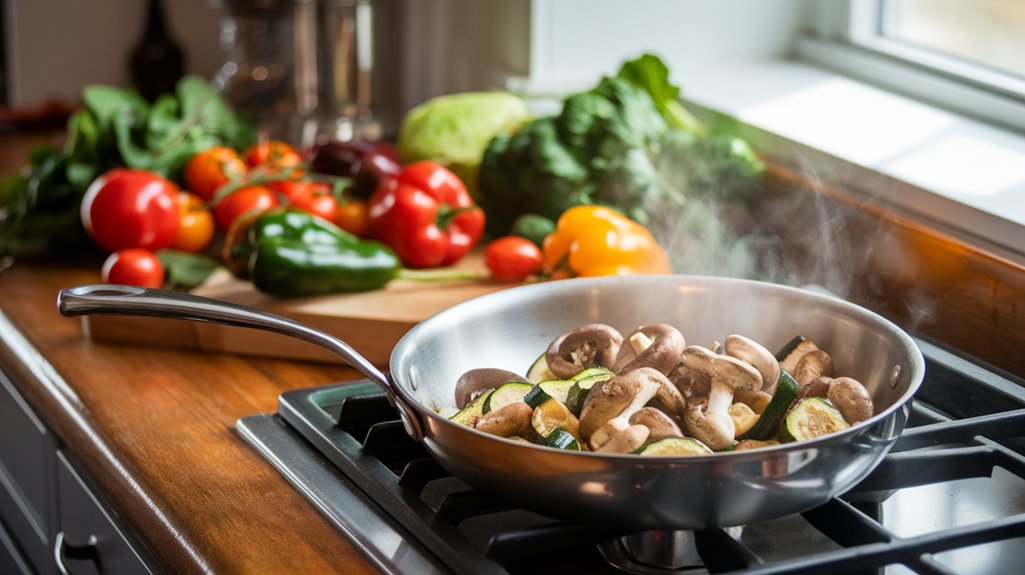
Cooking delicious vegetarian meals can be an exciting adventure, especially when you embrace the vibrant flavors and textures that plant-based ingredients offer.
I love experimenting in the kitchen, and here are a few tips to get you started:
- Explore spices: They can transform a simple dish into something extraordinary. Think cumin, paprika, or fresh herbs.
- Mix textures: Combine creamy, crunchy, and chewy elements for a more satisfying meal. Consider adding nuts, seeds, or roasted vegetables.
- Season well: Don’t shy away from salt and acidity. A squeeze of lemon or a splash of vinegar can elevate your dish.
With these ideas, you’ll find cooking vegetarian meals not only fulfilling but also incredibly delicious.
Dive in and enjoy the journey!
The Role of Community in the Movement
As I’ve explored the vegetarian movement, I’ve found that community plays a crucial role in fostering connections and sharing resources.
Local networks not only provide support but also create a vibrant exchange of knowledge that elevates our culinary experiences.
Together, we can cultivate a rich environment where ideas flourish and delicious meals abound.
Building Local Networks
While I’ve always believed in the power of food to unite people, the vegetarian movement has shown me just how essential community is in creating lasting change.
Building local networks not only fosters connections but also amplifies our impact. I’ve witnessed firsthand how collaboration can inspire action and commitment.
Here’s what I’ve learned:
- Shared experiences: Gathering for potlucks or cooking classes strengthens bonds and builds trust.
- Support systems: Local groups provide encouragement, making it easier to stick to vegetarian lifestyles.
- Collective advocacy: Mobilizing together for local initiatives amplifies our voices, influencing policies and promoting plant-based options.
Shared Resources and Knowledge
Sharing resources and knowledge within our vegetarian community has proven invaluable to the movement’s growth and sustainability. When I first embraced this lifestyle, I felt overwhelmed, but the support I found changed everything.
Local workshops, recipe exchanges, and online forums became my lifelines. Through sharing experiences, we’ve cultivated a treasure trove of tips on nutrition, cooking techniques, and ethical sourcing.
I’ve discovered incredible local farmers and co-ops thanks to fellow vegetarians who generously shared their insights. By pooling our resources, we’re not just enhancing our meals; we’re fostering a sense of belonging and empowerment.
Together, we create a vibrant tapestry of ideas, making it easier for newcomers to join the movement and feel at home in this green revolution.
Overcoming Common Misconceptions
How can we challenge the misconceptions surrounding vegetarianism?
It’s essential to address the stereotypes that often deter people from exploring a vegetarian lifestyle.
Let’s break down a few common myths:
- Vegetarians don’t get enough protein: Many plant-based foods, like beans, lentils, and quinoa, are packed with protein.
- It’s too expensive: Eating vegetarian can actually be budget-friendly; staples like rice, beans, and seasonal vegetables are often cheaper than meat.
- Vegetarian meals are bland: With the right spices and cooking techniques, plant-based dishes can be incredibly flavorful and diverse.
How to Get Started on Your Vegetarian Journey
Embarking on a vegetarian journey can feel daunting, yet it’s a rewarding adventure that opens up a world of culinary possibilities.
Start by gradually incorporating more plant-based meals into your diet; try Meatless Mondays or swapping out meat in your favorite recipes.
Explore local farmers’ markets for fresh produce and experiment with new ingredients like quinoa, lentils, and chickpeas.
Don’t forget to seek inspiration from cookbooks, blogs, and social media—there’s a treasure trove of vegetarian recipes waiting for you!
Keep your kitchen stocked with spices and herbs to enhance flavors.
Most importantly, listen to your body and find what works best for you.
The journey is personal, and every step brings you closer to a vibrant, healthy lifestyle.
Frequently Asked Questions
Can I Be Vegetarian While Still Eating Dairy and Eggs?
Absolutely, you can be vegetarian while still enjoying dairy and eggs!
I’ve found that this approach, often called lacto-ovo vegetarianism, allows for a diverse range of delicious meals.
I love incorporating eggs into my breakfasts and using cheese in my favorite dishes.
It’s a great way to get essential nutrients while still reducing meat consumption.
If you’re considering this lifestyle, you’ll discover a whole new world of tasty vegetarian recipes!
How Can I Ensure I’m Getting Enough Protein?
I’ve found that ensuring I get enough protein as a vegetarian isn’t as tricky as it seems.
I focus on incorporating a variety of plant-based foods like lentils, chickpeas, and quinoa into my meals. I also enjoy nuts, seeds, and tofu for added protein.
Plus, I make sure to include dairy and eggs in my diet when possible. Balancing these options keeps my meals nutritious and satisfying!
Are There Vegetarian Options for Fast Food?
Absolutely, there are plenty of vegetarian options at fast food places!
I often grab a veggie burger or a salad, both of which can be quite filling. Many chains offer wraps stuffed with fresh veggies and beans too.
Don’t forget about sides like fries or onion rings! I love customizing my order, adding extra toppings to make it even tastier.
Fast food doesn’t have to compromise my vegetarian lifestyle!
What Are Some Common Vegetarian Meal Prep Tips?
When I meal prep, I stick to a few key tips.
First, I batch-cook grains like quinoa or brown rice to save time.
I also chop a variety of colorful veggies, keeping them fresh in the fridge.
I love to incorporate protein sources like beans or lentils for balance.
Lastly, I always store meals in clear containers, making it easy to grab a nutritious option when I’m on the go.
It really simplifies my week!
How Do I Handle Social Situations as a Vegetarian?
Handling social situations as a vegetarian can be tricky, but I’ve found some strategies that help.
I always communicate my dietary choices in advance, so hosts can plan accordingly. When dining out, I look up menus beforehand to spot vegetarian options.
I also bring a dish to share, ensuring I’ll have something to enjoy. Most importantly, I stay confident in my choices, embracing the chance to educate others about vegetarianism as we share a meal.
Conclusion
As I’ve explored the Green Plate Revolution, I’ve discovered that embracing vegetarianism isn’t just a personal choice; it’s a powerful step toward a healthier planet and a vibrant lifestyle. By savoring delicious plant-based meals and connecting with a passionate community, I’ve found joy and purpose in every bite. So, if you’re ready to embark on this journey, remember: every meal is an opportunity to make a difference—let’s take that leap together and celebrate the green plate!
